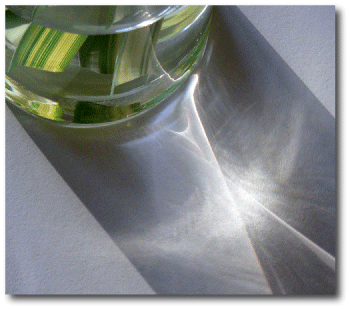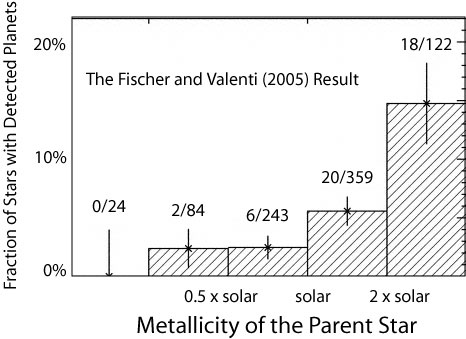
Image Source.
Hey Everybody, if you’ve been working on your fits to the second Systemic challenge system, send them to the e-mail address listed on the web-page given in the Sky and Telescope article.
I’ve been hearing many rumors floating around that there’s going to be a big planet announcement next week. Unfortunately, oklo.org has not yet joined the privileged ranks of the mainstream science press, so I haven’t been privy to any advance looks at the result that’s gonna come off the wire. I did hear, though, that it’s going to be an STScI announcement, so I did a little anticipatory detective work.
STScI runs HST, which means that the result will be the product of Hubble observations. In order to make Hubble observations, one needs to manage to get a block of fiercely competitive Hubble time, which means you need to write a successful Hubble proposal. The abstracts of winning Hubble proposals are posted publicly on NASA ADS. A quick search yields the following accepted proposal abstract (Proposal ID #10466), submitted by Dr. K. C. Sahu:
We propose to observe a Galactic bulge field continuously with ACS/WFC over a 7-day period. We will monitor ~167, 000 F, G, and K dwarfs down to V=23, in order to detect transits by orbiting Jovian planets. If the frequency of “hot Jupiters” is similar to that in the solar neighborhood, we will detect over 100 planets, more than doubling the number of extrasolar planets known. For the brighter stars with transits, we will confirm the planetary nature of the companions through radial- velocity measurements using the 8-m VLT. We will determine the metallicities of most of the planet-bearing stars as well as a control sample, through follow-up VLT spectroscopy. The metallicities of the target stars range over more than 1.5 dex, allowing for a determination of the dependence of planet frequency upon metallicity–a crucial element in understanding planet formation. We will be able to discriminate between the equally numerous disk and bulge stars via proper motions. Hence we will determine, for the first time, the frequencies of planets in two entirely different stellar populations. We will also determine for the first time the distribution of planetary radii for extrasolar planets for both these populations. Parallel observations with NICMOS will provide ultra-deep near-infrared images of a nearby bulge field, which will be used to determine the stellar luminosity and mass functions down to the brown-dwarf regime. The data will also be useful for a variety of spinoff projects, including a census of variable stars and of hot white dwarfs in the bulge, and the metallicity distribution of bulge dwarfs.
I looked at Sahu’s web page at STScI, where he writes:
At present, my research is mainly focused on a large HST program which involves monitoring of about 300,000 stars towards the Galactic bulge using the Advanced Camera System (ACS) on board HST, to search for extra-solar planets. The results are due to appear in the October 5, 2006 issue of Nature.
So clearly, the ACS data have been reduced, and it’s an excellent bet that they’re planning to announce the transit candidates that have emerged from their 7 days worth of ACS photometry. The number of transits to be announced is almost certainly more than two. This week’s announcement of WASP-1b and WASP-2b certainly didn’t produce a noticeable media splash, so there must be a lot of planets in the announcement. And given the past history of HST microlensing planet detections, I bet it’ll be the case that some of the parent stars of the soon-to-be-announced new transiting planets have indeed undergone a fairly rigorous spectroscopic follow-up with the VLT.
I think that spending a whole week of ACS time to stare at stars in the galactic bulge is a fairly worthwhile use of the HST (although I bet a lot of extragalactic astronomers might disagree). Here’s my take: In the mid-1990’s, it was believed that the stars of the galactic bulge are very metal-rich. In 1994, for example, McWillian and Rich 1994 reported an average bulge star metallicity of 0.2 “dex”, that is, ~60% greater than the solar value. More recently, however, Fulbright et al. 2006 have revised the average metallicity of the bulge downward to a value of -0.1 dex (~80% of the solar value). It thus appears that the metallicity distribution of the stars in the bulge is roughly similar to the metallicity distribution of stars in the solar neighborhood.
We know from Debra Fischer and Jeff Valenti’s work that the rate of short-period giant planet occurence is a strong function of stellar metallicity:

All other things being equal, we can use the above diagram to inform an estimate of the number of planets that Sahu and company will announce. The hot Jupiter occurence rate in a solar-neighborhood type metallicity population is of order 0.7%. About 10% of hot Jupiters will be observable in transit. About half of those transits will be clobbered by the effect of a binary companion sharing the pixel and driving the detection below threshold. For a 7-day survey, about 60% of the hot Jupiters will actually get picked up, given constant coverage and good control of detector systematics (which HST certainly has). This means that Sahu should see (167,000)x(0.007)x(0.1)x(0.5)x(0.6)=35 transiting planets.
The problem, however, will be that there are many events which will look like planet transits, including grazing eclipsing binary stars, transiting M-dwarf stars, and the surprisingly common situation where a background eclipsing binary star shares the pixel with a foreground target star, a so-called blend situation. Dave Charbonneau and his collaborators have written extensively about all of the different pitfalls that can cause a wide-field transit survey to turn up false positives.
So my guess is that there will be of order 200 transit candidates in the ACS data for 167,000 stars. The brightest and most promising of these will have been sent to the VLT for spectroscopic follow-up. If the sensitivity limit of the survey (as stated in the proposal abstract) is V~23, then the candidate stars will likely have V~20-21. Even with the VLT, it’s tough to get accurate radial velocity measurements for stars this dim. So a lack of an observed binary stellar companion will probably be taken as a confirmation of the presence of a planet. (This is all complete speculation on my part.) Going even further out on a limb, my guess is that they have ~100 stars that show transit signatures, and which do not have a spectroscopically detectable binary stellar companion. Although it’ll be hard to further sort the wheat from the chaff, I’ll harbor a guess that 1/3 of the planets that will likely be announced are bona-fide.
Assuming that this is what actually occurs at the press conference, then we’ll have a very interesting result — not so much about the planets (which will be hard to characterize owing to the dim parent stars) — but because of what it tells us about the formation of the galactic bulge. Right now, there are several competing theories for how the bulge formed. One possibility is that scattering of stars by the Milky Way’s galactic bar has populated the Milky Way’s bulge with stars. Another possibility is that the bulge stars are the result of many disrupted globlular cluster or dwarf-galaxy like objects.
A measurement of the planet population of the bulge stars can allow us to distinguish between these two possiblities. If the planet occurance rate is similar to the galactic neighborhood (which I’m guessing will be the gist of the press conference) then the bulge stars are likely to have formed under low-density conditions. This would favor a bar-scattering type of scenario. If the planet occurence rate is zero or very low (which is unlikely, given that they are having a press conference) that would imply that the stars formed in a high-density environment. A crowded star formation leads to a ultraviolet ionizing radiation field that makes it difficult for planets to form and then migrate inward to become hot Jupiters.
There was a remarkable study done with HST in the late 1990s, and published by Gilliland et al. 2000. HST obtained a 8.3-day photometric time series for 34,000 stars in the globular cluster 47 Tucanae. The data, when reduced, show a total absence of transiting planets. This result shows the power of both the environment variable (the 47 Tucanae stars formed in an intensely irradiated region of star formation) and the metallicity variable (the metallicity of the 47 Tucanae stars is about 20% the solar value).
Finally, it’s always good to look at costs. According to the Wikipedia, the total cost of building, launching, servicing, and running HST has been of order 6 billion dollars. It started working as planned in 1994, and will thus have ~15 years of fully functional use. The seven days of ACS time were therefore worth 7.6 million dollars. This is comfortably more than the cost of building a special-purpose telescope to probe the terrestrial planets that are almost certainly orbiting Alpha Centauri B. (For more information, see these oklo.org posts: 1, 2, 3, 4, 5.)

Dr. Kahu did a similar study already in 2004 (proposal #9750).
BBC (July 2, 2004): Hubble discovers 100 new planets
http://news.bbc.co.uk/2/hi/science/nature/3856401.stm
If this is confirmed, in seven days we will have doubled the number of planets known in nine years — Steven Beckwith, Space Telescope Science Institute
Nothing was heard of the discoveries before the press conference announcement.
Hi Jyril,
That’s interesting information, and would seem to explain the discrepancy between the 167,000 stars listed in the more recent proposal abstract and the 300,000 stars listed on Sahu’s home page. They probably decided to go back and work harder on the confirmation end before announcing any planets. They must have used a lot of large-telescope follow-up time.
When the candidate stars are at magnitude v=21+, it’s got to be extremely difficult and time-consuming to get ironclad follow-up confirmation on a large number of planets. (It’s even hard for surveys that have candidates in the V=11-14 range, where the stars are 10,000 times brighter). I know, for example, that the TrES survey had to carefully cull many candidates prior to finding TrES-1 and TrES-2. It’s a similar story for WASP and OGLE as well.
If they’ve got 300,000 total stars, then there should be about 60+/- sqrt(60) transiting planets in their data set if bulge stars formed under the same conditions that pertained to disk star formation. I would be very suspicious of a 100+ planet figure, which would indicate that somehow the bulge stars are _more_ effective at forming planets en masse. Given that the bulge stars may be the product of highly irradiated star-forming environments, I just don’t see how they can have a higher-than-solar-neighborhood planet forming efficiency. A 100+ number almost certainly indicates that a fair number of false positives remain unidentified.
In any case, it’s interesting to speculate, but it’ll be even more interesting to see what actually gets announced. I’m going to be reading that Nature paper the moment it comes out!
Hi Greg,
There will be a news conference on this discovery.
So your guess is correct!
http://www.nasa.gov/home/hqnews/2006/sep/HQ_M06152_HST_Planetscgrv.html
Hi wl,
Thanks for the link. I see that the blurb on the press conference summary refers to “candidate” planets, rather than planets, so my guess is that they will not have detailed RV follow-up on all of the candidates.
G
Hi all,
the press-release of the new 16 transiting planets is here:
http://hubblesite.org/newscenter/newsdesk/archive/releases/2006/34/text/
Mauro
Those who cannot view the Nature article can read the preprint at
http://arxiv.org/abs/astro-ph/0610098
It has a complete list of the planetary candidates and their measured properties.
The total number of announced candidates is nearly half the estimated 35. Since only two planets were confirmed with RV measurements, they used very stringent acceptance criteria (for example, maximum radius R = 1.4 Rj). I wonder how many potential planets were among the rejected candidates.